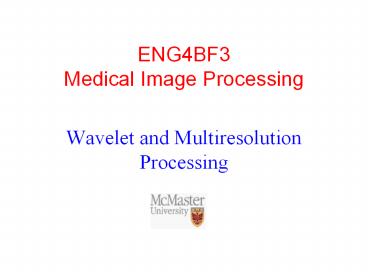Wavelet and Multiresolution Processing - PowerPoint PPT Presentation
Title:
Wavelet and Multiresolution Processing
Description:
... holds the properties of orthogonal, (anti-)symmetric and compactly supported. ... condition for orthogonal wavelets. 26. 27. Haar Wavelet. 28. Wavelet ... – PowerPoint PPT presentation
Number of Views:1685
Avg rating:3.0/5.0
Title: Wavelet and Multiresolution Processing
1
ENG4BF3Medical Image Processing
- Wavelet and Multiresolution Processing
2
Introduction
- Unlike Fourier transform, whose basis functions
are sinusoids, wavelet transforms are based on
small waves, called wavelets, of limited
duration. - Fourier transform provides only frequency
information, but wavelet transform provides
time-frequency information. - Wavelets lead to a multiresolution analysis of
signals. - Multiresolution analysis representation of a
signal (e.g., an images) in more than one
resolution/scale. - Features that might go undetected at one
resolution may be easy to spot in another.
3
Multiresolution
4
Image Pyramids
5
Image pyramids
- At each level we have an approximation image and
a residual image. - The original image (which is at the base of
pyramid) and its P approximation form the
approximation pyramid. - The residual outputs form the residual pyramid.
- Approximation and residual pyramids are computed
in an iterative fashion. - A P1 level pyramid is build by executing the
operations in the block diagram P times.
6
Image pyramids
- During the first iteration, the original 2Jx2J
image is applied as the input image. - This produces the level J-1 approximate and level
J prediction residual results - For iterations jJ-1, J-2, , J-p1, the previous
iterations level j-1 approximation output is
used as the input.
7
Image pyramids
- Each iteration is composed of three sequential
steps - Compute a reduced resolution approximation of the
input image. This is done by filtering the input
and downsampling (subsampling) the filtered
result by a factor of 2. - Filter neighborhood averaging, Gaussian
filtering - The quality of the generated approximation is a
function of the filter selected
8
Image pyramids
- Upsample output of the previous step by a factor
of 2 and filter the result. This creates a
prediction image with the same resolution as the
input. - By interpolating intensities between the pixels
of step 1, the interpolation filter determines
how accurately the prediction approximates the
input to step 1. - Compute the difference between the prediction of
step 2 and the input to step 1. This difference
can be later used to reconstruct progressively
the original image
9
(No Transcript)
10
Subband coding
- In subband coding, an image is decomposed into a
set of bandlimited components, called subbands. - Since the bandwidth of the resulting subbands is
smaller than that of the original image, the
subbands can be downsampled without loss of
information.
11
Perfect Reconstruction Filter
Z transform
Goal find H0, H1, G0 and G1 so that
12
Perfect Reconstruction Filter Conditions
If
Then
13
Perfect Reconstruction Filter Families
QMF quadrature mirror filters
CQF conjugate mirror filters
14
2-D
15
Example of Filters
16
(No Transcript)
17
The Haar Transform
- Haar proposed the Haar Transform in 1910, more
than 70 years before the wavelet theory was born.
- Actually, Haar Transform employs the Haar wavelet
filters but is expressed in a matrix form. - Haar wavelet is the oldest and simplest wavelet
basis. - Haar wavelet is the only one wavelet basis, which
holds the properties of orthogonal,
(anti-)symmetric and compactly supported.
18
The Haar Wavelet Filters
19
(No Transcript)
20
Multiresolution Expansions
- Series Expansions
- A function can be expressed as
- where
Dual function of
Complex conjugate operation
21
Multiresolution Expansions
- Series Expansions
- Orthonormal basis
- biorthogonal
22
Multiresolution Expansions
- Scaling functions
- Integer translations and dyadic scalings of a
scaling function - Express as the combination of
23
(No Transcript)
24
Multiresolution Expansions
- Scaling functions
- Dilation equation for scaling function
- are called scaling function
coefficients - Example Haar wavelet,
25
Multiresolution Expansions
- Wavelet functions
- are called wavelet function
coefficients - Translation and scaling of
- condition for orthogonal wavelets
26
(No Transcript)
27
Haar Wavelet
28
Wavelet Transform 1-D
- Wavelet series expansion
- where
29
(No Transcript)
30
Wavelet Transform 1-D
- Discrete Wavelet Transform
- where
Approximation coefficients
Detail coefficients
31
Fast Wavelet Transform Decomposition
32
Fast Wavelet Transform Decomposition
33
Example Haar Wavelet
34
Fast Wavelet Transform Reconstruction
35
Fast Wavelet Transform Reconstruction
36
Fast Wavelet Transform Reconstruction
37
Wavelet Transform vs. Fourier Transform
38
Wavelet Transform 2-D
Scaling function
Wavelet functions
Horizontal direction
Vertical direction
Diagonal direction
39
2-D Wavelet Transform Decomposition
40
2-D Wavelet Transform Reconstruction
41
(No Transcript)
42
(No Transcript)
43
Fig. 7.24 (g)
44
Image Processing by Wavelet Transform
- Three Steps
- Decompose the image into wavelet domain
- Alter the wavelet coefficients, according to your
applications such as denoising, compression, edge
enhancement, etc. - Reconstruct the image with the altered wavelet
coefficients.
45
(No Transcript)
46
Wavelet Transform based Denoising
- Three Steps
- Decompose the image into several scales.
- For each wavelet coefficient y
- Hard thresholding
- Soft thresholding
- Reconstruct the image with the altered wavelet
coefficients.
47
(No Transcript)
48
Assignment
- Get familiar with the Matlab Wavelet Toolbox.
- By using the Wavelet Toolbox functions, write a
program to realize the soft- thresholding
denoising on a noisy MRI image.
49
End of the lecture































